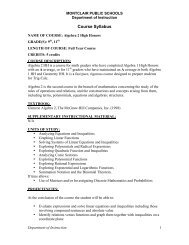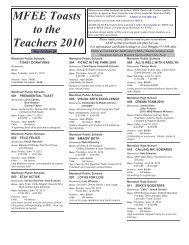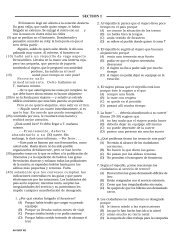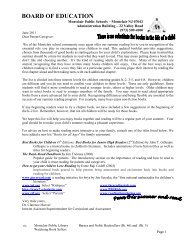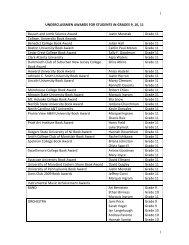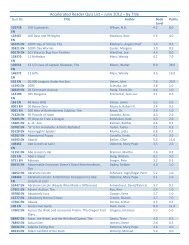Montclair Public Schools CCSS Algebra 2 Honors Unit 3: Marshall ...
Montclair Public Schools CCSS Algebra 2 Honors Unit 3: Marshall ...
Montclair Public Schools CCSS Algebra 2 Honors Unit 3: Marshall ...
You also want an ePaper? Increase the reach of your titles
YUMPU automatically turns print PDFs into web optimized ePapers that Google loves.
<strong>Montclair</strong> <strong>Public</strong> <strong>Schools</strong><br />
<strong>CCSS</strong> <strong>Algebra</strong> 2 <strong>Honors</strong> <strong>Unit</strong> 3: <strong>Marshall</strong> A.b<br />
Subject <strong>Algebra</strong> 2 Grade 11 <strong>Unit</strong> # 3 Pacing Marking Period 3<br />
<strong>Unit</strong> Name<br />
2013-2014<br />
Modeling with Exponential, Logarithmic, Trigonometric Functions<br />
Overview<br />
Students will begin by understanding the building blocks of geometry. Basic terms, theorems, and proofs will be introduced. Students will explore these<br />
ideas by learning how to create proofs (formal and informal) and by generating constructions (using compass and straightedge, or geometric software<br />
and other methods).<br />
Standard # Standard MC,<br />
SC,<br />
or<br />
AC<br />
N.RN.1<br />
N.RN.2<br />
A.SSE.3<br />
Explain how the definition of the meaning of<br />
rational exponents follows from extending the<br />
properties of integer exponents to those values,<br />
allowing for a notation for radicals in terms of<br />
rational exponents. For example, we define<br />
5^(1/3) to be the cube root of 5 because we<br />
want (5^(1/3))^3 = 5*(3/3) to hold, so<br />
(5^(1/3))^3 must equal 5.<br />
Rewrite expressions involving radicals and<br />
rational exponents using the properties of<br />
exponents.<br />
Use properties of exponents to transform<br />
expressions for exponential functions. For<br />
example, the expression 1.15^t can be<br />
rewritten as (1.15^(1/12))^(12t) = 1.012^(12t)<br />
to reveal the approximate equivalent monthly<br />
SLO<br />
#<br />
MC 1<br />
2<br />
MC 3<br />
4<br />
MC 5<br />
6<br />
Student Learning Objectives<br />
Use properties of integer exponents to explain and<br />
convert between expressions involving radicals and<br />
rational exponents, using correct notation. For<br />
example, we define 5^(1/3) to be the cube root of 5<br />
because we want (5^(1/3))^3 = 5*(3/3) to hold, so<br />
(5^(1/3))^3 must equal 5.<br />
Determine if a value raised to a rational exponent will<br />
result in a real number rather than an imaginary value.<br />
(e.g., 4^(1/2) = 2, (-27)^(1/3) = -3, (-4)^(1/4) is not real,<br />
etc.)<br />
Write equivalent expressions for exponential functions<br />
using the properties of exponents.<br />
Reinforcement of laws of exponents. Understand how<br />
x^(1/4) * x^(3/4) is equivalent to 1. Rewrite 4^(1/2) *<br />
16^(1/4)=2^2<br />
Write equivalent expressions for exponential functions<br />
using the properties of exponents.<br />
Students to analyze examples of exponential growth<br />
and decay models (relating to biology and chemistry<br />
Depth of<br />
Knowledge<br />
4<br />
3<br />
4<br />
3<br />
4<br />
4
F.BF.1<br />
interest rate if the annual rate is 15%.<br />
Write a function that describes a relationship<br />
between two quantities. Combine standard<br />
function types using arithmetic operations. For<br />
example, build a function that models the<br />
temperature of a cooling body by adding a<br />
constant function to a decaying exponential,<br />
and relate these functions to the model.<br />
7<br />
8<br />
courses) as well as compounding interest models<br />
(relating to finance and economics courses).<br />
Compare exponential and linear growth rates and<br />
determine during which intervals exponential growth<br />
may be slower than that of linear growth.<br />
Construct a function that combines standard function<br />
types using arithmetic operations to model a<br />
relationship between two quantities.<br />
3<br />
4<br />
F.LE.4<br />
For exponential models, express as a logarithm<br />
the solution to ab^c = d, where a, c, and d are<br />
numbers and the base b is 2, 10, or e, evaluate<br />
the logarithm using technology.<br />
9<br />
SC 10<br />
Students will construct functional models of real-world<br />
situations.<br />
Identify the inverse relationship that exists between<br />
logarithms and exponential functions. Students<br />
should apply this to problem solving involving<br />
exponential and logarithmic functions.<br />
3<br />
3<br />
11<br />
Express as a logarithm, the solution to ab^c = d, where<br />
a, c, and d are numbers and the base is 2, 10 , or e.<br />
3<br />
12<br />
Evaluate the logarithm using either graphing or<br />
scientific technology.<br />
3<br />
13<br />
Apply laws of logarithms to either expand or contract<br />
a given logarithmic expression.<br />
4<br />
F.IF.7e<br />
Graph exponential and logarithmic functions<br />
showing intercepts, and end behavior, and<br />
trigonometric functions, showing period,<br />
midline, and amplitude.<br />
SC 14<br />
Graph functions expressed symbolically and show key<br />
features of the graph (including intercepts, intervals<br />
where the function is increasing, decreasing, positive<br />
or negative; relative maxima and minima; symmetries,<br />
and end behavior) by hand in simple cases and using<br />
technology in more complicated cases.<br />
(Students encouraged to use graphing technologies)<br />
2<br />
15<br />
Interpret the parameters in an exponential function in<br />
2<br />
2013-2014
terms of its context.<br />
F.TF.1<br />
Understand the radian measure of an angle as<br />
the length of the arc on the unit circle<br />
subtended by the angle.<br />
16<br />
AC 17<br />
Contrast how exponential and logarithmic functions<br />
are different from linear and quadratic functions.<br />
Use the radian measure of an angle to find the length<br />
of the arc in the unit circle subtended by the angle and<br />
find the measure of the angle given the length of the<br />
arc.<br />
3<br />
2<br />
F.TF.2<br />
Explain how the unit circle in the coordinate<br />
plane enables the extension of trigonometric<br />
functions to all real numbers, interpreted as<br />
radian measures of angles traversed<br />
counterclockwise around the unit circle.<br />
18<br />
AC 19<br />
Reinforce calculation of arc length from prior<br />
Geometry content.<br />
Explain how the unit circle in the coordinate plane<br />
enables the extension of trigonometric functions to all<br />
real numbers (interpreted as radian measures of all<br />
angles traversed counterclockwise around the unit<br />
circle).<br />
2<br />
1<br />
20<br />
Relate prior content from Geometry to unit circle,<br />
specifically 30-60-90 and 45-45-90 triangles.<br />
2<br />
F.TF.8<br />
Prove Pythagorean Identity (sin x)^2 + (cos x)^2<br />
= 1 to find sin x, cos x, tan x, given sin x, cos x,<br />
or tan x, and the quadrant of the angle.<br />
21<br />
AC 22<br />
Facilitate student discovery of the relationship of<br />
quadrant 1 to the other quadrants of the unit circle<br />
and relate to the ASTC mnemonic device.<br />
Reinforce Pythagorean theorem from Geometry<br />
content. Construct angle relationships using<br />
fundamentals in right triangle trigonometry and<br />
identify SOHCAHTOA mnemonic device<br />
1<br />
2<br />
F.TF.5<br />
Choose trigonometric functions to model<br />
periodic phenomena with specified amplitude,<br />
frequency and midline.<br />
23 Use the Pythagorean Identity (sin x)^2 + (cos x)^2 = 1<br />
to find sin x, cos x, tan x, given sin x, cos x, or tan x,<br />
and the quadrant of the angle.<br />
AC 24 Choose trigonometric functions to model periodic<br />
phenomena with specified amplitude, frequency and<br />
midline.<br />
1<br />
1<br />
2013-2014
F.IF.7e<br />
Mathematical<br />
Practice #<br />
Graph exponential and logarithmic functions<br />
showing intercepts, and end behavior, and<br />
trigonometric functions, showing period,<br />
midline, and amplitude.<br />
AC 25<br />
Graph functions expressed symbolically and show key<br />
features of the graph, by hand in simple cases and<br />
using technology for more complicated cases.<br />
26 Graph trigonometric functions showing period,<br />
midline, and amplitude.<br />
Selected Opportunities for Connections to Mathematical Practices<br />
1<br />
1<br />
1<br />
2<br />
3<br />
4<br />
5<br />
6<br />
7<br />
8<br />
2013-2014<br />
SLOs 6, 7, 10, 15, 16, 24<br />
SLOs 1, 2, 7, 12<br />
SLOs 6, 7, 8, 9, 24, 25, 26<br />
SLOs 6, 7, 8, 9, 14, 15, 24, 26<br />
SLOs 7, 11, 12, 13, 14, 18, 25<br />
SLOs 1, 2, 5, 11, 13, 15, 17, 18<br />
SLOs 10, 13, 14, 15, 16, 21<br />
SLOs 1, 2, 3, 4, 19, 20<br />
Big Ideas<br />
Radical expressions can be written in terms of rational (fractional) exponents, which are governed by the laws of exponents in a manner<br />
consistent with expressions containing integer exponents.<br />
Exponential and logarithmic functions are inverses.<br />
Exponential functions model real world situations modeling growth and decay.<br />
Angles can be measured in degrees and radians, which unlike degrees relate to a distance measurement (i.e., arc length).<br />
The unit circle is a useful tool in showing the relations between trigonometric functions and the repetitive values in angles.<br />
Basic trigonometric functions have periodicity (repetitive behavior), a frequency, and may have amplitude.<br />
Essential Questions<br />
Can one conclude that exponential and logarithmic functions are inverses by analyzing algebraic and graphical details?<br />
What are exponential functions and how can they be used to model growth and decay situations in the sciences and finance?<br />
How can logarithms be used to solve exponential equations?<br />
Why must students learn radian measure in addition to degree measure?<br />
How can trigonometric functions be used to model periodic event?<br />
Assessments<br />
Tests, quizzes, and homework aligned to the curriculum content. <strong>Algebra</strong> 2 Academic <strong>Unit</strong> 3 Model Assessment is a 44-minute, single-class-period<br />
assessment that should be administered at the end of the third marking period.
Key Vocabulary<br />
Rational exponents, Radicals<br />
Exponential modeling, Logarithms<br />
Trigonometry – radians, unit circle, period, midline, amplitude<br />
Function properties – increasing/decreasing, end behavior<br />
Suggested Resources (list specific chapters and or page numbers from existing text that correspond to the SLOs and Standards)<br />
SLO Sections and page numbers from Prentice Hall New Jersey <strong>Algebra</strong> 2, Pearson Education, Inc. 2009<br />
1 7-4 on pp. 385-390<br />
2 7-1 on pp. 370-373<br />
3, 4, 5 7-1 on p. 368 and 7-4 on p. 387<br />
6 to 9 8-1, 8-2 on pp. 430-445, 479<br />
10 to 13 8-3 on pp. 439-452<br />
14 to 16 8-3 on pp. 439-452 addressing graphical features of exponential and logarithmic graphs.<br />
17 13-3 on pp. 726-730<br />
18 13-3 on p. 728, 725 (classroom activity/demonstration)<br />
19 13-2 on pp. 720-723.<br />
20 Geometry Review on p. 717<br />
21 Exercise #50 on p. 723 (All Students Take Calculus) Quadrant 1 ALL trig function values are positive, Q2 Only Sine is positive etc.<br />
22 14-3 on pp. 792-794<br />
23 14-1 on p. 779<br />
24 to 26 Period 13-1 on pp. 710-716, Graphing sine 13-4 on pp. 734-742, Graphing Cosine 13-5 on pp. 743-748.<br />
Common<br />
Core<br />
http://www.parcconline.org/samples/mathematics/high-school-mathematics<br />
http://www.state.nj.us/education/modelcurriculum/math/<br />
http://ccss.lexington4.net/unpacking-the-standards<br />
http://www.engageny.org/<br />
http://www.illustrativemathematics.org/standards/hs<br />
http://www.ccsstoolbox.com/parcc/PARCCPrototype_main.html<br />
http://www.smarterbalanced.org/sample-items-and-performance-tasks/<br />
2013-2014



